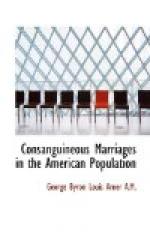TABLE XV. ----------------------------------------------------- |Sex of Children.| |----------------| Marriage. | Male.| Female. | Masculinity. ----------------------------------------------------- 1st cousins and nearer| 165 | 164 | 100 More distant cousins | 95 | 73 | 131 -----------------------------------------------------
[Footnote 41: Huth, Marriage of Near Kin. Appendix.]
The unusual ratios are of course due principally to a “run of luck,” and this table only shows that if consanguinity is a determining factor in sex, its influence is negligible when a small number of cases is considered. It is interesting accordingly to note that of 100 children of incestuous unions and from uncle-niece and aunt-nephew marriages from Bemiss, Huth and other sources, the sex distribution was 48 males and 52 females, giving a negative masculinity of 92.
While in general the evidence presented in this chapter is somewhat conflicting, that which bears most directly upon the problem does not substantiate the hypothesis of Westermarck. The evidence in favor of the theory is all indirect and is open to other interpretations. It is hardly safe to go to the other extreme and to assert that consanguinity diminishes masculinity. The safest, and withal the most reasonable conclusion is that consanguinity in the parents has no appreciable effect upon the sex of the child.
CHAPTER IV
CONSANGUINITY AND REPRODUCTION
The principal object of nearly every previous discussion of the intermarriage of kindred, has been either to prove or to disprove some alleged injurious effect upon the offspring. The writers who have treated the subject may be divided into three groups. First, those who have maintained in accordance with popular opinion that consanguinity per se is a cause of degeneracy or that in some mysterious way kinship of the parents produces certain diseases in the children. In this group Boudin in France and Bemiss in America are typical. Second, those who have flatly contradicted this position and have asserted that on the whole such marriages are beneficial, and that crossing is in itself injurious to the race. Huth is the chief exponent of this theory, although he admits that where degenerate conditions exist in the parents consanguinity in marriage may not be beneficial. The third group holds that cousin marriages in themselves, especially if not carried through too many generations, are not harmful, but that if any hereditary tendency to malformation or disease exists in the family of the parents, this tendency, inherited through both parents is strongly intensified in the offspring, and that consequently an increased percentage of the offspring of cousin marriage may be afflicted with hereditary diseases. This group includes a number of the later writers such as Feer and Mayet. Among the earlier discussions, those of Dally in France and George H. Darwin in England take substantially this position. On the whole this theory seems to be the most reasonable one and with a few modifications it will be seen to account for all the facts herein presented.




